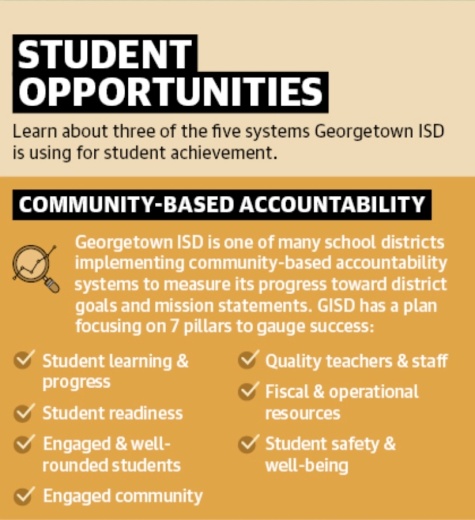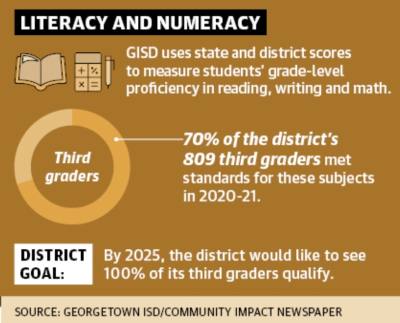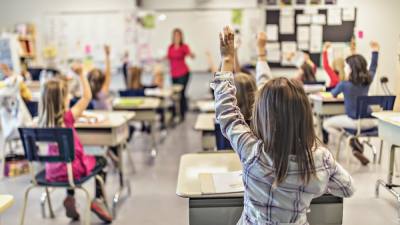GISD officials began talking about five systems in 2018 to achieve goals based on its mission statements and input from the community. The board’s goals center on helping students become college-, career- and military-ready, and develop social and emotional awareness.
Every year, district officials roll out different phases of each system’s plan to reach these goals by 2025. The district wants to meet state standards and simultaneously keep the needs and desires of parents and students in mind, said Wes Vanicek, chief strategist for assessment and feedback.
“The goal is to create a school system that is based on the community’s values for their education organization,” Vanicek said. “Then, we want to show progress toward becoming that school system. The other half of that is when we do that, it informs the system of how to get better.”
GISD is also creating a community-based accountability system to ensure the district maintains its and mission statements, Vanicek said. The district sought input from a diverse pool of community members through public forms and outreach. Taking this input into account, district officials created a plan to implement seven pillars of accountability, such as ensuring every student has teachers and staff who care about their learning and well-being, by 2025.
“For forever, accountability has been based on how well kids score on the STAAR, TAKS and TAAS test,” Vanicek said. “Community-based accountability is an effort to shift that focus and make it more about what our community desires as a school system.”
Self improvement
In addition to holding itself accountable, GISD is helping students improve using a learner profile system. Each student has six attributes to work toward such as creating original ideas and developing relationships with people.
For the 2020-21 school year, the district built a data entry system to track student progress. By 2025, all students would receive personalized feedback and could track their own progress, said Lindsay Harris, GISD chief strategist of leadership and culture.
While they are training to be better learners, students can also prepare for their futures. GISD has developed multiple pathways for students to be ready for college, a career or the military. In 2020, 76% of seniors met state-defined requirements to be ready for college, a career or the military. The district would like for 100% of students to meet the requirements by 2025, said Cynthia Pike, director of college, career and military readiness for GISD.
To help students reach this goal, the district is encouraging more students to take Advanced Placement courses or pursue industry certification courses that GISD offers. The courses include automotive services, welding and pharmacy technician skills, and GISD trains teachers to help students become certified.
“We have a student who was working at a local restaurant and earned her ServSafe Manager certification while working there,” Pike said. “She was promoted within a month to a managing position while being a senior in high school.”
The district is not focusing on military readiness for 2021-22 and is leaving discussions up to families, Pike said.
For younger students, the district wants them to meet grade-level proficiency in reading, writing and math by third grade. In the last school year, 70% of the district’s 809 third graders met standards for these subjects, Vanicek said. By 2025, the district would like to see 100% of its third graders qualify.
GISD measures grade-level proficiency through test scores from state and district tests. To help students meet proficiency, the district does not require them to meet standards for every assessment, said Terri Conrad, chief strategist for learning and design for GISD.
“A student can earn grade-level proficiency [through any of these assessments],” Conrad said. “That’s why we have multiple measures, so that each student has a style of assessment that is going to benefit them more.”
Social and emotional
To accomplish the mission in developing students beyond academics, the district is implementing a social-emotional learning system. Social-emotional learning teaches students self-awareness, social awareness and responsible decision-making. The program is also intended to support learning in the classroom, said Heather Moeller, social emotional learning and mental health specialist for GISD.
“All learning has an emotional component,” Moeller said. “If our job is to create experiences that prepare students to work and cooperate with the world, then we cannot fail to address the emotional undercurrent of learning.”
Instead of starting the program with the entire district at once, GISD is rolling out an onboarding process for four different groups of schools at different times. By 2023, the district wants the program to reach the entire high school level.
“We want to save high schools at the tail end so we can develop SEL specifically for their experience,” said David Rainey, GISD director of counseling services.Overall, the district is honing in on sending students off into the world feeling prepared, Harris said.
“Are students leaving our system ready for life, whatever life is, after they leave our system?” she said.








